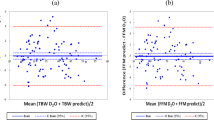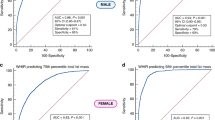Abstract
Objective:
To compare different field methods for estimating body fat mass with a reference value derived by a three-component (3C) model in pre-school and school children across Europe.
Design:
Multicentre validation study.
Subjects:
Seventy-eight preschool/school children aged 4–10 years from four different European countries.
Methods:
A standard measurement protocol was carried out in all children by trained field workers. A 3C model was used as the reference method. The field methods included height and weight measurement, circumferences measured at four sites, skinfold measured at two–six sites and foot-to-foot bioelectrical resistance (BIA) via TANITA scales.
Results:
With the exception of height and neck circumference, all single measurements were able to explain at least 74% of the fat-mass variance in the sample. In combination, circumference models were superior to skinfold models and height–weight models. The best predictions were given by trunk models (combining skinfold and circumference measurements) that explained 91% of the observed fat-mass variance. The optimal data-driven model for our sample includes hip circumference, triceps skinfold and total body mass minus resistance index, and explains 94% of the fat-mass variance with 2.44 kg fat mass limits of agreement. In all investigated models, prediction errors were associated with fat mass, although to a lesser degree in the investigated skinfold models, arm models and the data-driven models.
Conclusion:
When studying total body fat in childhood populations, anthropometric measurements will give biased estimations as compared to gold standard measurements. Nevertheless, our study shows that when combining circumference and skinfold measurements, estimations of fat mass can be obtained with a limit of agreement of 1.91 kg in normal weight children and of 2.94 kg in overweight or obese children.
This is a preview of subscription content, access via your institution
Access options
Subscribe to this journal
Receive 12 print issues and online access
$259.00 per year
only $21.58 per issue
Buy this article
- Purchase on Springer Link
- Instant access to full article PDF
Prices may be subject to local taxes which are calculated during checkout

Similar content being viewed by others
References
de Onis M, Blossner M, Borghi E . Global prevalence and trends of overweight and obesity among preschool children. Am J Clin Nutr 2010; 92: 1257–1264.
Rokholm B, Baker JL, Sorensen TI . The levelling off of the obesity epidemic since the year 1999--a review of evidence and perspectives. Obes Rev 2010; 11: 835–846.
Ahrens W, Bammann K, Siani A, Buchecker K, De Henauw S, Iacoviello L et al. The IDEFICS cohort: design, characteristics and participation in the baseline survey. Int J Obes (Lond) 2011; 35 (Suppl 1): S3–15.
Bammann K, Peplies J, Sjöström M, Lissner L, De Henauw S, Galli C et al. Assessment of diet. Physical activity and biological, social and environmental factors in a multi-centre European project on diet- and lifestyle-related disorders in children (IDEFICS). J Public Health 2006; 14: 279–289.
Bray GA, DeLany JP, Harsha DW, Volaufova J, Champagne CC . Evaluation of body fat in fatter and leaner 10-y-old African American and white children: the Baton Rouge Children’s Study. Am J Clin Nutr 2001; 73: 687–702.
Eisenmann JC, Heelan KA, Welk GJ . Assessing body composition among 3- to 8-year-old children: anthropometry, BIA, and DXA. Obes Res 2004; 12: 1633–1640.
Elberg J, McDuffie JR, Sebring NG, Salaita C, Keil M, Robotham D et al. Comparison of methods to assess change in children’s body composition. Am J Clin Nutr 2004; 80: 64–69.
Parker L, Reilly JJ, Slater C, Wells JC, Pitsiladis Y . Validity of six field and laboratory methods for measurement of body composition in boys. Obes Res 2003; 11: 852–858.
Wells JC, Fuller NJ, Dewit O, Fewtrell MS, Elia M, Cole TJ . Four-component model of body composition in children: density and hydration of fat-free mass and comparison with simpler models. Am J Clin Nutr 1999; 69: 904–912.
Bammann K, Sioen I, Huybrechts I, Casajus JA, Vicente-Rodriguez G, Cuthill R et al. The IDEFICS validation study on field methods for assessing physical activity and body composition in children: design and data collection. Int J Obes (Lond) 2011; 35 (Suppl 1): S79–S87.
Fuller NJ, Jebb SA, Laskey MA, Coward WA, Elia M . Four-component model for the assessment of body composition in humans: comparison with alternative methods, and evaluation of the density and hydration of fat-free mass. Clin Sci (Lond) 1992; 82: 687–693.
Wells JC, Williams JE, Chomtho S, Darch T, Grijalva-Eternod C, Kennedy K et al. Pediatric reference data for lean tissue properties: density and hydration from age 5 to 20 y. Am J Clin Nutr 2010; 91: 610–618.
McCrory MA, Gomez TD, Bernauer EM, Mole PA . Evaluation of a new air displacement plethysmograph for measuring human body composition. Med Sci Sports Exerc 1995; 27: 1686–1691.
Dempster P, Aitkens S . A new air displacement method for the determination of human body composition. Med Sci Sports Exerc 1995; 27: 1692–1697.
Fields DA, Hull HR, Cheline AJ, Yao M, Higgins PB . Child-specific thoracic gas volume prediction equations for air-displacement plethysmography. Obes Res 2004; 12: 1797–1804.
Prentice AM . Stable isotopic methods for measuring energy expenditure. Applications of the doubly-labelled-water (2H2(18)O) method in free-living adults. Proc Nutr Soc 1988; 47: 259–268.
Westerterp KR . Body composition, water turnover and energy turnover assessment with labelled water. Proc Nutr Soc 1999; 58: 945–951.
Marfell-Jones M, Olds T, Stewart A, Carter L . International Standards for Anthropometric Assessment. International Society for the Advancement of Kinanthropometry: Potchefstroom: South Africa, 2006.
Houtkooper LB, Lohman TG, Going SB, Hall MC . Validity of bioelectric impedance for body composition assessment in children. J Appl Physiol 1989; 66: 814–821.
Cole TJ, Freeman JV, Preece MA . British 1990 growth reference centiles for weight, height, body mass index and head circumference fitted by maximum penalized likelihood. Stat Med 1998; 17: 407–429.
Cole TJ, Bellizzi MC, Flegal KM, Dietz WH . Establishing a standard definition for child overweight and obesity worldwide: international survey. BMJ 2000; 320: 1240–1243.
Cole TJ, Flegal KM, Nicholls D, Jackson AA . Body mass index cut offs to define thinness in children and adolescents: international survey. BMJ 2007; 335: 194.
Stomfai S, Ahrens W, Bammann K, Kovacs E, Marild S, Michels N et al. Intra- and inter-observer reliability in anthropometric measurements in children. Int J Obes (Lond) 2011; 35 (Suppl 1): S45–S51.
Vettorazzi C, Smits E, Solomons NW . The interobserver reproducibility of bioelectrical impedance analysis measurements in infants and toddlers. J Pediatr Gastroenterol Nutr 1994; 19: 277–282.
Kettaneh A, Heude B, Lommez A, Borys JM, Ducimetiere P, Charles MA . Reliability of bioimpedance analysis compared with other adiposity measurements in children: the FLVS II Study. Diabetes Metab 2005; 31: 534–541.
Collins AL, McCarthy HD . Evaluation of factors determining the precision of body composition measurements by air displacement plethysmography. Eur J Clin Nutr 2003; 57: 770–776.
Fields DA, Higgins PB, Radley D . Air-displacement plethysmography: here to stay. Curr Opin Clin Nutr Metab Care 2005; 8: 624–629.
Greenland S . Modeling and variable selection in epidemiologic analysis. Am J Public Health 1989; 79: 340–349.
Bland JM, Altman DG . Statistical methods for assessing agreement between two methods of clinical measurement. Lancet 1986; 1: 307–310.
McCarthy HD . Body fat measurements in children as predictors for the metabolic syndrome: focus on waist circumference. Proc Nutr Soc 2006; 65: 385–392.
Taylor RW, Jones IE, Williams SM, Goulding A . Evaluation of waist circumference, waist-to-hip ratio, and the conicity index as screening tools for high trunk fat mass, as measured by dual-energy X-ray absorptiometry, in children aged 3–19 y. Am J Clin Nutr 2000; 72: 490–495.
Taylor RW, Williams SM, Grant AM, Ferguson E, Taylor BJ, Goulding A . Waist circumference as a measure of trunk fat mass in children aged 3–5 years. Int J Pediatr Obes 2008; 3: 226–233.
Brambilla P, Bedogni G, Moreno LA, Goran MI, Gutin B, Fox KR et al. Crossvalidation of anthropometry against magnetic resonance imaging for the assessment of visceral and subcutaneous adipose tissue in children. Int J Obes (Lond) 2006; 30: 23–30.
Reilly JJ, Wilson J, Durnin JV . Determination of body composition from skinfold thickness: a validation study. Arch Dis Child 1995; 73: 305–310.
Radley D, Cooke CB, Fuller NJ, Oldroyd B, Truscott JG, Coward WA et al. Validity of foot-to-foot bio-electrical impedance analysis body composition estimates in overweight and obese children. Int J Body Compos Res 2009; 7: 15–20.
Reilly JJ, Gerasimidis K, Paparacleous N, Sherriff A, Carmichael A, Ness AR et al. Validation of dual-energy x-ray absorptiometry and foot-foot impedance against deuterium dilution measures of fatness in children. Int J Pediatr Obes 2010; 5: 111–115.
Montagnese C, Williams JE, Haroun D, Siervo M, Fewtrell MS, Wells JC . Is a single bioelectrical impedance equation valid for children of wide ranges of age, pubertal status and nutritional status? Evidence from the 4-component model. Eur J Clin Nutr 2013; 67 (Suppl 1): S34–S39.
Horlick M, Arpadi SM, Bethel J, Wang J, Moye J, Cuff P et al. Bioelectrical impedance analysis models for prediction of total body water and fat-free mass in healthy and HIV-infected children and adolescents. Am J Clin Nutr 2002; 76: 991–999.
Himes JH . Challenges of accurately measuring and using BMI and other indicators of obesity in children. Pediatrics 2009; 124 (Suppl 1): S3–22.
Nakao T, Komiya S . Reference norms for a fat-free mass index and fat mass index in the Japanese child population. J Physiol Anthropol Appl Human Sci 2003; 22: 293–298.
Kurtoglu S, Mazicioglu MM, Ozturk A, Hatipoglu N, Cicek B, Ustunbas HB . Body fat reference curves for healthy Turkish children and adolescents. Eur J Pediatr 2010; 169: 1329–1335.
Chumlea WC, Guo SS, Kuczmarski RJ, Flegal KM, Johnson CL, Heymsfield SB et al. Body composition estimates from NHANES III bioelectrical impedance data. Int J Obes Relat Metab Disord 2002; 26: 1596–1609.
Moreno LA, Mesana MI, Gonzalez-Gross M, Gil CM, Ortega FB, Fleta J et al. Body fat distribution reference standards in Spanish adolescents: the AVENA Study. Int J Obes (Lond) 2007; 31: 1798–1805.
Addo OY, Himes JH . Reference curves for triceps and subscapular skinfold thicknesses in US children and adolescents. Am J Clin Nutr 2010; 91: 635–642.
Wells JC, Williams JE, Chomtho S, Darch T, Grijalva-Eternod C, Kennedy K et al. Body-composition reference data for simple and reference techniques and a 4-component model: a new UK reference child. Am J Clin Nutr 2012; 96: 1316–1326.
Acknowledgements
We would like to thank all the members of the study teams, and especially the children and their parents for their enthusiastic participation in the study. This work was done as part of the IDEFICS Study (www.idefics.eu). We gratefully acknowledge the financial support of the European Community within the sixth RTD Framework Programme under contract no. 016181 (FOOD). MW Peeters, T De Vriendt and I Sioen are financially supported by the Research Foundation Flanders (FWO). B Tubic is financially supported by the New Research Amanuensis programme for medical students at the Sahlgrenska Academy, University of Gothenburg, Sweden.
Author information
Authors and Affiliations
Consortia
Corresponding author
Ethics declarations
Competing interests
The authors declare no conflict of interest.
Rights and permissions
About this article
Cite this article
Bammann, K., Huybrechts, I., Vicente-Rodriguez, G. et al. Validation of anthropometry and foot-to-foot bioelectrical resistance against a three-component model to assess total body fat in children: the IDEFICS study. Int J Obes 37, 520–526 (2013). https://doi.org/10.1038/ijo.2013.13
Received:
Revised:
Accepted:
Published:
Issue Date:
DOI: https://doi.org/10.1038/ijo.2013.13
Keywords
This article is cited by
-
Improving cardiorespiratory fitness protects against inflammation in children: the IDEFICS study
Pediatric Research (2022)



